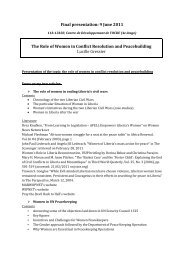Women's Economic Opportunity Index - Economist Intelligence Unit
Women's Economic Opportunity Index - Economist Intelligence Unit
Women's Economic Opportunity Index - Economist Intelligence Unit
- No tags were found...
You also want an ePaper? Increase the reach of your titles
YUMPU automatically turns print PDFs into web optimized ePapers that Google loves.
Women’s economic opportunityA new global index and rankingThe Equal pay for equal work indicator shows that although most countries covered in the pilotWomen’s <strong>Economic</strong> <strong>Opportunity</strong> <strong>Index</strong> have legislation that enshrines the principle of equal pay,implementation remains weak, owing to a lack of financial resources and trained personnel. In Europe,where policy is generally good, enforcement remains weak, albeit substantially better than in Africa andAsia. In the <strong>Index</strong>, Germany, Finland and Denmark earned the top score for implementation of equal payprovisions, along with the US and Canada.Mandating equality of opportunity and treatment in employment (captured by the Non-discriminationindicator) is another important step in providing full opportunities for women. As with equal pay,however, many countries boast good policies but weak enforcement. According to the ILO, “economicindependence or at least co-determination in resource distribution within the family is highest whenwomen earn wages and salaries or are employers, lower when they are own-account workers and lowestwhen they are contributing family workers.” 5 For this indicator, the Americas region posts similarperformance to Europe on average, both in terms of policy and practice. Policies and enforcementmechanisms lag behind in Asia and Africa.Even when women are employed in male-dominated fields, they are often confronted with a “glassceiling”—an implicit form of discrimination—that may discourage them from working and that impedescareer progress. For example, only 2% of CEOs of Fortune 500 companies, and 5% of those in the FTSEstock index, are women. In Turkey this figure is 12%, on par with Norway, and Brazil has 11% of womenCEOs, making them among the economies with the highest percentage of female CEOs (World <strong>Economic</strong>Forum 2010). 6 Perceived opportunities for women to rise to senior management positions are captured byEqual pay for equal workILO Convention 100 (average score)8PolicyPractice76543215. “Global employment trendsfor women”, InternationalLabour Organisation: Geneva,March 2009.6. “The corporate gender gapreport 2010”, World <strong>Economic</strong>Forum: Geneva, March 20100Africa(25 countries in region)Americas(19 countries in region)Asia(33 countries in region)Europe(34 countries in region)Oceania(2 countries in region)Source: Creation of a coding and scoring scheme by the <strong>Economist</strong> <strong>Intelligence</strong> <strong>Unit</strong> based on International Labour Organisation documents.Geographical regions created by the <strong>Unit</strong>ed Nations Statistics Division.Due to data limitations the model does not cover every country in the world. As a result, country coverage within each region is not alwayscomplete. Expanded country coverage is expected in future editions of the model.14© <strong>Economist</strong> <strong>Intelligence</strong> <strong>Unit</strong> Limited 2010




